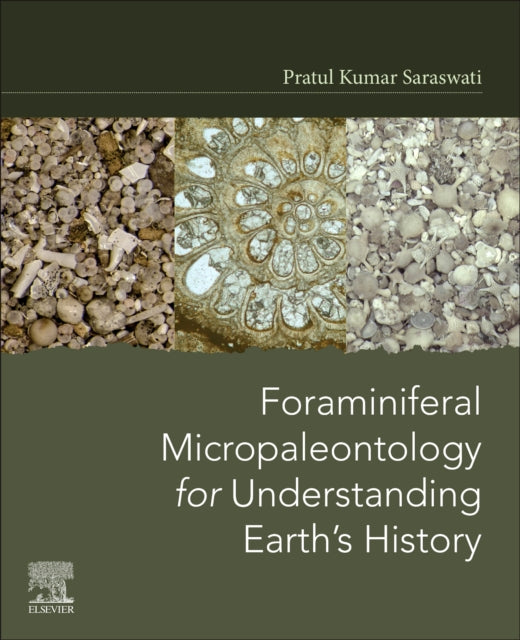Pratul Kumar Saraswati
Foraminiferal Micropaleontology for Understanding Earth's History
Foraminiferal Micropaleontology for Understanding Earth's History
- Condition: Brand new
- UK Delivery times: Usually arrives within 2 - 3 working days
- UK Shipping: Fee starts at £2.39. Subject to product weight & dimension
Bulk ordering. Want 15 or more copies? Get a personalised quote and bigger discounts. Learn more about bulk orders.
Couldn't load pickup availability
- More about Foraminiferal Micropaleontology for Understanding Earth's History
Foraminiferal Micropaleontology for Understanding Earths History is a rapidly growing field that uses new findings on taxonomy, classification, and biostratigraphy of foraminifera to interpret Earth's history. It is particularly useful in paleoclimate and paleoenvironment interpretation, paleoceanography, and biostratigraphy, and has been promoted by oil exploration due to its exceptional use in subsurface stratigraphy.
Format: Paperback / softback
Length: 340 pages
Publication date: 18 June 2021
Publisher: Elsevier Science Publishing Co Inc
Foraminiferal Micropaleontology plays a vital role in unraveling Earth's history by shedding light on the taxonomy, classification, and biostratigraphy of these remarkable organisms. These tiny marine creatures, known as foraminifera, hold immense value in understanding past climates and environments. The study of foraminifera gained significant momentum due to its exceptional utility in subsurface stratigraphy, particularly in oil exploration. Over the past two decades, remarkable technological advancements in imaging microfossils and geochemical microanalysis have provided a wealth of novel information about foraminifera.
In the field of biology, foraminiferal micropaleontology delves into the intricacies of foraminifera's morphology, anatomy, and classification. These organisms exhibit a wide range of shapes, sizes, and adaptations, making them valuable tools in various scientific disciplines. Foraminifera are utilized in fields such as paleoenvironment and paleoclimate interpretation, paleoceanography, and biostratigraphy to continuously refine the Geologic Time Scale.
One of the key applications of foraminifera is in paleoenvironment and paleoclimate interpretation. These tiny creatures have a remarkable ability to survive in extreme environmental conditions, allowing them to preserve records of past climates. By studying the composition and distribution of foraminifera in sedimentary rocks, scientists can reconstruct ancient environments, including temperature, salinity, and sea level changes. This information is crucial for understanding climate change and its impact on Earth's ecosystems over millions of years.
Paleoceanography is another area where foraminifera play a vital role. These organisms are found in vast quantities in marine sediments, and their shells can provide valuable insights into past ocean conditions. By analyzing the isotopic composition of foraminifera's shells, scientists can reconstruct past ocean temperatures, salinity, and nutrient levels. This information is essential for understanding the evolution of marine life and the impact of climate change on the oceans.
Biostratigraphy is another application of foraminifera that contributes to our understanding of Earth's history. By studying the distribution and abundance of foraminifera species in sedimentary rocks, scientists can establish geological timelines and correlate different geological events. Foraminifera are particularly useful in dating sedimentary rocks and identifying fossilized organisms, which can provide valuable information about the evolution of life on Earth.
In conclusion, foraminiferal Micropaleontology is a crucial field that contributes significantly to our understanding of Earth's history. These tiny organisms offer valuable geochemical proxies for paleoclimate and paleoenvironment interpretation, making them essential tools in oil exploration and other scientific disciplines. With ongoing technological advancements and innovative research, foraminifera will continue to provide new insights into our planet's past and help us better prepare for the challenges of the future.
Weight: 710g
Dimension: 191 x 233 x 23 (mm)
ISBN-13: 9780128239575
This item can be found in:
UK and International shipping information
UK and International shipping information
UK Delivery and returns information:
- Delivery within 2 - 3 days when ordering in the UK.
- Shipping fee for UK customers from £2.39. Fully tracked shipping service available.
- Returns policy: Return within 30 days of receipt for full refund.
International deliveries:
Shulph Ink now ships to Australia, Belgium, Canada, France, Germany, Ireland, Italy, India, Luxembourg Saudi Arabia, Singapore, Spain, Netherlands, New Zealand, United Arab Emirates, United States of America.
- Delivery times: within 5 - 10 days for international orders.
- Shipping fee: charges vary for overseas orders. Only tracked services are available for most international orders. Some countries have untracked shipping options.
- Customs charges: If ordering to addresses outside the United Kingdom, you may or may not incur additional customs and duties fees during local delivery.


